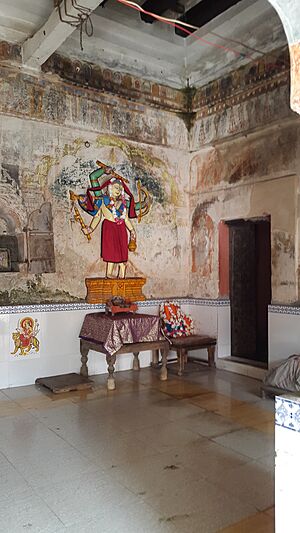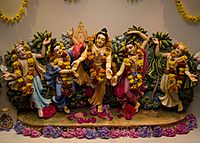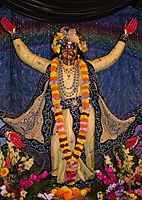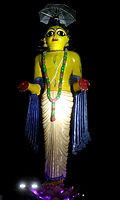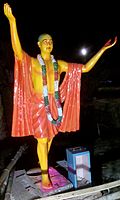Chaitanya Mahaprabhu facts for kids
Quick facts for kids Chaitanya Mahaprabhu |
|
|---|---|
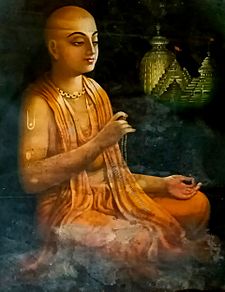
Chaitanya Mahaprabhu
|
|
| Birth Date | 18 February 1486 Nabadwip, Bengal Sultanate (present-day West Bengal, India) |
| Died on | 14 June 1534 (aged 48) Puri, Gajapati Kingdom (present-day Odisha, India) |
| Birth name | Vishvambhar Mishra |
| Guru/teacher | Swami Isvara Puri (mantra guru); Swami Kesava Bharati (sannyas guru) |
| Philosophy | Bhakti yoga, Achintya Bheda Abheda |
Chaitanya Mahaprabhu (IAST: Caitanya Mahāprabhu) was an important Indian saint who lived in the 15th century. His followers believe he was a special form of the Hindu deities Radha and Krishna combined.
Chaitanya Mahaprabhu taught a way of worshiping Krishna using joyful songs and dances called kirtan. This way of worship greatly influenced Vaishnavism, a branch of Hinduism, especially in Bengal. He also taught a deep spiritual idea called Achintya Bheda Abheda Tattva.
He started a spiritual group known as Gaudiya Vaishnavism. He also taught about Bhakti yoga, which is a path of devotion. He made the chanting of the Hare Krishna Maha-mantra very popular. Chaitanya Mahaprabhu also wrote eight special prayers called Shikshashtakam.
People sometimes called him Gauranga or Gaura because his skin had a golden color. His birthday is celebrated as Gaura-purnima. He was also called Nimai because he was born under a Neem tree.
Contents
Life Story of Chaitanya Mahaprabhu
The name Chaitanya means "one who is aware." Maha means "Great," and Prabhu means "Lord" or "Master." Chaitanya's birth name was Vishvambhar Mishra. He was the second son of Jagannath Mishra and Sachi Devi. His parents were Brahmins, which is a priestly class in Hindu society. His family came from a village in Sylhet and later moved to Nabadwip.
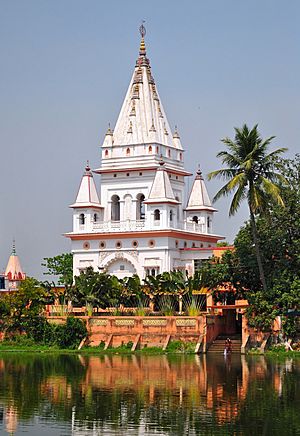
According to a book called Chaitanya Charitamrita, Chaitanya was born in Nabadwip (in present-day West Bengal) on February 18, 1486. This happened on a full moon night during a lunar eclipse.
Stories say that Chaitanya loved chanting and singing Krishna's names even when he was very young. However, he was also very interested in learning and studying Sanskrit. When he traveled to Gaya to perform a ceremony for his father, he met his spiritual teacher, Ishvara Puri. Ishvara Puri taught him a special mantra (a sacred sound or phrase).
This meeting changed Chaitanya's life a lot. When he returned to Bengal, the local Vaishnavas, led by Advaita Acharya, were amazed by his sudden change from a scholar to a devoted follower. Soon, Chaitanya became the main leader of their Vaishnava group.
After leaving Bengal, Chaitanya became a sannyasa (a monk). He traveled all over India for several years, always chanting Krishna's divine names. He walked through many places, including Baranagar and Chhatrabhog. From Chhatrabhog, he traveled by boat to Puri.
He spent the last 24 years of his life in Puri, Odisha. Puri is famous for its great Jagannath temple. The king of Puri at that time, Prataprudra Dev, believed Chaitanya was an avatar of Krishna. The king was a big supporter of Chaitanya's chanting gatherings.
Vrindavan, known as the “City of Temples,” had many holy places related to Radha and Krishna. These places were lost over time. Chaitanya rediscovered them in the 16th century. In 1515, Chaitanya visited Vrindavan to find these lost holy sites. He wandered through the sacred forests in a spiritual trance. People believe that his divine power helped him find all the important places where Krishna had performed his pastimes. This included seven main temples that are still worshiped by Vaishnavas today.
Who Was Chaitanya Mahaprabhu?
According to writings from the 16th century, Chaitanya Mahaprabhu showed his amazing Universal Form (a cosmic form of God) on several occasions. This was similar to how Lord Krishna had shown it. He showed it to important followers like Advaita Ācārya and Nityānanda Prabhu.
Some Hindu scriptures, like the Vishnu Sahasranama and Bhavishya Purana, also mention Chaitanya Mahaprabhu as an incarnation of Krishna. Gaudiya Vaishnavas believe Chaitanya is Lord Krishna himself. They think he appeared in a hidden form in the Kali Yuga (the current age) to show the easiest way to become aware of Krishna.
Unlike other avatars of Krishna, Chaitanya Mahaprabhu did not fight any demons. Instead, he focused on making the Hare Krishna Mahamantra popular. A book called Chaitanya Bhagavat says that Mahaprabhu predicted that Krishna's holy name would be sung in every town and village around the world. This prediction has come true, especially with the International Society for Krishna Consciousness (ISKCON) spreading his teachings globally.
What Did Chaitanya Mahaprabhu Teach?
-
Pancha Tattva deities on a Vaishnava altar. From left to right: Advaita Acharya, Nityananda, Chaitanya, Gadadhara Pandita, Srivasa.
Lord Chaitanya's direct teachings are written in Sanskrit verses called Siksastakam. These eight verses are believed to contain the complete philosophy of Gaudiya Vaishnavism in a short form.
Chaitanya's main teachings are summarized in ten important principles called dasa mula:
- The main proof for spiritual truths comes from holy scriptures. These scriptures teach the following nine points.
- Krishna is the Supreme Absolute Truth.
- Krishna has all kinds of powers and energies.
- Krishna is the source of all spiritual joy and emotions.
- Individual souls (called jivas) are small parts of the Lord.
- When souls are not free, they are affected by the material world.
- When souls become free, they are no longer affected by the material world.
- Souls and the material world are both different from and also the same as the Lord.
- Pure devotion is the only way to become free and reach God.
- The highest goal is to have pure love for Krishna.
His Philosophy and Followers
Chaitanya Mahaprabhu was a student of Isvara Puri, who was part of the Madhvacharya tradition. Even though he was initiated into this tradition, Chaitanya's teachings became a unique path within Vaishnavism.
Chaitanya himself did not write many books, except for the Siksastaka (eight verses of instruction). He asked some of his closest followers, known as the Six Gosvamis of Vrindavan, to write down and explain the spiritual ideas he taught. These six saints were Rupa Goswami, Sanatana Goswami, Gopala Bhatta Goswami, Raghunatha Bhatta Goswami, Raghunatha Dasa Goswami and Jiva Goswami. They helped organize the Gaudiya Vaishnava teachings.
Later, people like Narottama Dasa and Srinivasa Acharya helped spread these teachings throughout Bengal, Odisha, and other parts of Eastern India.
In the early 17th century, Kalachand Vidyalankar, a follower of Chaitanya, made his teachings popular in Bengal. He traveled across India, promoting ideas like anti-untouchability, social justice, and education for everyone. He encouraged people to fight against illiteracy and the caste system.
From the very beginning of Chaitanya's bhakti (devotion) movement, people from all backgrounds, including Muslims and Hindus, joined in. In the 19th century, Sri Ramakrishna Paramahamsa, a famous sage, also emphasized Chaitanya's path of devotion.
In the 20th century, Chaitanya's teachings reached the Western world. Baba Premananda Bharati was one of the first to bring Gaudiya Vaishnavism to English speakers. Later, A. C. Bhaktivedanta Swami Prabhupada (1896-1977) founded The International Society for Krishna Consciousness (ISKCON). This organization helped spread Chaitanya's teachings and the chanting of the Hare Krishna mantra all over the world. Many temples dedicated to Krishna and Chaitanya have been built outside India.
Cultural Impact
Chaitanya Mahaprabhu had a huge impact on the culture of Bengal, Odisha, and Manipur. Many people in these areas still worship him daily as an avatar of Krishna. Some believe that his influence led to a kind of "Renaissance" (a period of great new ideas) in Bengal.
There have also been films made about Chaitanya. For example, Nilachaley Mahaprabhu (1957) was a Bengali film about him. Another Bengali film, Lawho Gouranger Naam Re, is being made about his life.
See also
 In Spanish: Chaitania para niños
In Spanish: Chaitania para niños
- Vrindavan
- Gauranga
- Jagannath Temple (Puri)
- Pancha Tattva (Vaishnavism)
- Prabhupāda


